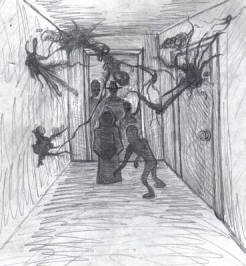
Shadow People
Shadow people (also known as shadow men, shadow folk, or shadow beings) are supernatural shadow-like creatures of both modern folklore and paranormal popular culture that are said to appear as dark forms seen mostly in peripheral vision. Anecdotal reports of shadow people occupy a similar role in popular culture to ghost sightings.
Several principles based in science can be used to explain reports of shadow people, including optical illusions or hallucinations brought on by physiological/psychological circumstances, drug use, and the interaction of external agents on the human body.
Images seen in peripheral areas of vision can be caused by pareidolia, a condition in which the brain incorrectly interprets random patterns of light/shadow or texture as being familiar patterns such as faces and human forms. The same condition can also be observed in macular vision in low light conditions, or when viewing a complex but random image. A common example would be perceiving a shadow, thrown by an item of furniture in a darkened room, as being a person.
Several principles based in science can be used to explain reports of shadow people, including optical illusions or hallucinations brought on by physiological/psychological circumstances, drug use, and the interaction of external agents on the human body.
Images seen in peripheral areas of vision can be caused by pareidolia, a condition in which the brain incorrectly interprets random patterns of light/shadow or texture as being familiar patterns such as faces and human forms. The same condition can also be observed in macular vision in low light conditions, or when viewing a complex but random image. A common example would be perceiving a shadow, thrown by an item of furniture in a darkened room, as being a person.
Hypnagogia, also known as "waking-sleep", a physiological condition in which a person is part-way between sleeping and waking, can also account for such perceptions. During hypnagogia, a person can be conscious and aware of their environment, but also in a dream-like state where they can perceive images from their subconscious. People experiencing waking-sleep commonly report the sensation of lights or shadows moving around them, as well as other visual hallucinations. A feeling of dread is also a sensation that occurs when experiencing hypnagogia. Hypnagogia is sometimes known as 'the faces in the dark phenomenon' because those who experience this state commonly report seeing faces while experiencing waking-sleep. Similar hypotheses have been put forward linking this condition to a number of other apparent paranormal experiences, including alien abductions, paranormal nocturnal visitations, and religious experiences such as contact with angels or demons.
The use of narcotics and psychotropic agents, including methamphetamine, cocaine, MDMA (Ecstasy) and LSD can produce human shaped hallucinations. Dopaminergic drugs such as pramipexole can sometimes cause these hallucinations.
Electromagnetic fields have been demonstrated to interfere with the functions of the temporal lobe, creating altered states of perception in which auditory and visual hallucinations can occur. Researchers have used electromagnetic fields to recreate many experiences similar to those reported during paranormal encounters. Researchers have also documented correlations between variances in naturally-occurring magnetic fields and areas where paranormal events have been reported.
In addition, certain neurological conditions, such as photosensitive complex partial seizures and Dementia with Lewy bodies, have also been known to cause individuals to experience visual hallucinations.
The use of narcotics and psychotropic agents, including methamphetamine, cocaine, MDMA (Ecstasy) and LSD can produce human shaped hallucinations. Dopaminergic drugs such as pramipexole can sometimes cause these hallucinations.
Electromagnetic fields have been demonstrated to interfere with the functions of the temporal lobe, creating altered states of perception in which auditory and visual hallucinations can occur. Researchers have used electromagnetic fields to recreate many experiences similar to those reported during paranormal encounters. Researchers have also documented correlations between variances in naturally-occurring magnetic fields and areas where paranormal events have been reported.
In addition, certain neurological conditions, such as photosensitive complex partial seizures and Dementia with Lewy bodies, have also been known to cause individuals to experience visual hallucinations.
